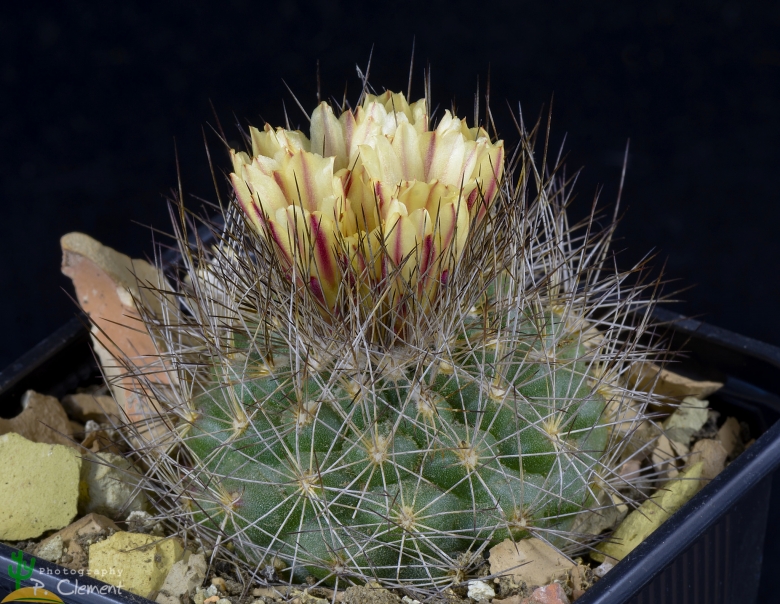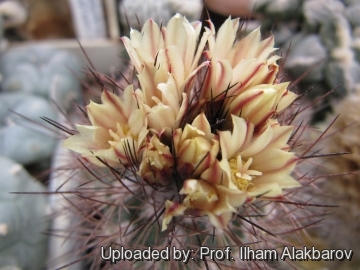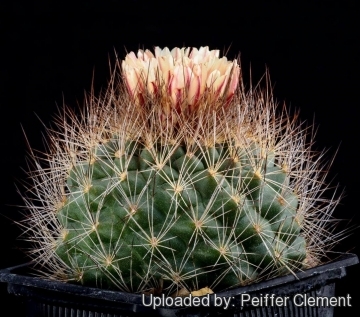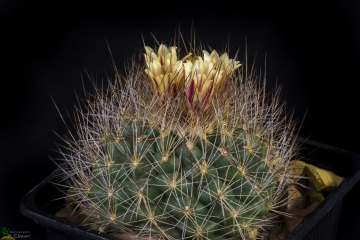Accepted Scientific Name: Acharagma aguirreanum (Glass & R.A.Foster) Glass
Guía Identif. Cact. Amenazadas México 1: [1] [AC/AG]. 1998 [15 Dec 1997] Glass

Gymnocactus aguirreanus (Acharagma aguirreanum) Photo by: Peiffer Clement
Origin and Habitat: Acharagma aguirreanumSN|87]]SN|87]] occurs in the western edge of the Sierra de la Paila,Coahuila, Mexico (Extent of of occurrence less than1 km²).
Altitude: It grows at an altitude of about 1400-1600 metres above sea level.
Habitat and Ecology: It grows in semi-desert on low hills and washes in shady areas, such as along canyon walls or under bushes, but quite to the contrary, many of the plants grows wedged in the brunt of the full sun on limestone ridges. The species is critically endangered . The total population numbers is less than 1000 individuals in a continuing decline due to illegal collecting. The same area support endemic succulents and xerophyte plants such as Ariocarpus fissuratusSN|2114]]SN|2114]], Astrophytum capricorne var. aureumSN|3526]]SN|3526]], Epithelantha bokeiSN|12641]]SN|12641]], Grusonia bradtianaSN|7500]]SN|7500]], Lophophora williamsiiSN|1117]]SN|1117]], Mammillaria chionocephalaSN|15848]]SN|15848]], Neolloydia conoideaSN|10089]]SN|10089]], Agave lechuguillaSN|23013]]SN|23013]], Dasylirion texensis, Euphorbia antisyphilitica, Hechtia glomerata, Fouquieria splendensSN|15717]]SN|15717]], Larrea tridentata and many others.
More...Synonyms:
Description: Acharagma aguirreanum, often misspelled: "aguirreana" is a small plant with yellowish to reddish yellow flowers at the stem tips.
Note: Acharagma is a genus formed by only two small species of cacti: Acharagma roseana and Acharagma aguirreana from northern Mexico. This plants previously classificated as Escobaria are instead related to Pediocactus and Lophophora, DNA sequence clearly support the hypothesis that Acharagma is a distinct ‘good’ genus not closely related to Escobaria.
Habit: Plants usually solitary unless damaged.
Stem: Globose to depressed spherical, soft, medium to dark green, often tinged with bronze-rose or purple, to 5 cm high, 5-7 cm in diameter.
Tubercles: Fleshy, pyramidal-conical, not grooved, somewhat flexible, to 5 mm long.
Areoles: Apical, without glands.
Spines: Numerous all more or less similar.
Central spines: 2 to many off-white near the bases to brownish-black towards the tips,
Radial spines: 13-16, often in two series, 8–15 mm long either whitish with darker tips or even orange to plum coloured.
Flowers: From the stem apex, yellowish to reddish yellow, 18 mm long, to 20 mm in diameter. Stigma-lobes 5-6 yellow. Perianth-segments eciliate
Fruits: Greenish purple or bronze coloured, to 12 mm long, 3.5 mm in diameter.
Seeds: Dark-purplish red to black, berrylike, indeishent.
More...Bibliography: Major references and further lectures
1) Edward Anderson “The Cactus family” Timber Press, Incorporated, 2001
2) James Cullen, Sabina G. Knees, H. Suzanne Cubey "The European Garden Flora Flowering Plants: A Manual for the Identification of Plants Cultivated in Europe, Both Out-of-Doors and Under Glass" Cambridge University Press, 11/Aug/2011
3) David R Hunt; Nigel P Taylor; Graham Charles; International Cactaceae Systematics Group. "The New Cactus Lexicon" dh books, 2006
4) Carsten Hobohm “Endemism in Vascular Plants” Springer, 2013
5) Anderson, E.F., Fitz Maurice, B & Fitz Maurice, W.A. 2002. Acharagma aguirreanum. In: IUCN 2013. “IUCN Red List of Threatened Species.” Version 2013.2. <www.iucnredlist.org>. Downloaded on 20 February 2014.
6) Edgar Lamb, Brian Lamb “The Illustrated Reference on Cacti & Other Succulents” Volume 5 Blandford Press, 1978
7) Moeller-Villar G. “Sierra de la Paila.” In: Aztekia 11: 24–28.1988.
8) Pilbeam J, Weightman B. “Ariocarpus etcetera”. Castle Colour, Norwich, UK.2006.
9) Glass C, Foster R. “Gymnocactus aguirreanus. A new species from southern Coahuila, Mexico.” im: Cact Succ J (US) 44(2): 80–81. 1972.
10) Chalet J–M. “Four lovely days in Sierra Paila.” in: Cactus and Co. VII (1): 44–63. 2003.
11) Bravo-Hollis H, Sánchez-Mejorada H. “Las cactáceas de México II” . Universidad Nacional Autónoma de México.1991.
12) Zlatko Janeba & Richard kalas “Acharagma aguirreanum in Sierra de la Paila. A rare find in cactus paradise” Cactus and succulent Journal Volume 79 number 5 2007
13) Urs Eggli, Leonard E. Newton: “Etymological Dictionary of Succulent Plant Names.” Springer, Berlin/Heidelberg 2010
14) C. Glass, R. Foster “Gymnocactus aguirreanus: a new species from southern Coahuila, Mexico.” In:Cactus and Succulent Journal. Los Angeles 44(2): 80–81 1972.
15) Guía para la Identificación de Cactáceas Amenazadas de México. 1997.
More... Gymnocactus aguirreanus (Acharagma aguirreanum) Photo by: Prof. Ilham Alakbarov
Gymnocactus aguirreanus (Acharagma aguirreanum) Photo by: Prof. Ilham Alakbarov Gymnocactus aguirreanus (Acharagma aguirreanum) Photo by: Peiffer Clement
Gymnocactus aguirreanus (Acharagma aguirreanum) Photo by: Peiffer Clement Gymnocactus aguirreanus (Acharagma aguirreanum) Photo by: Peiffer Clement
Gymnocactus aguirreanus (Acharagma aguirreanum) Photo by: Peiffer Clement Gymnocactus aguirreanus (Acharagma aguirreanum) Photo by: Peiffer Clement
Gymnocactus aguirreanus (Acharagma aguirreanum) Photo by: Peiffer ClementCultivation and Propagation: Acharagma aguirreanumSN|87]]SN|87]] is very slow growing. Because of the tap root they are very rot prone, so use highly gritty compost with much drainage and water regularly in summer, but do not overwater, it prefer a completely dry place during winter. An unheated greenhouse would be perfect. It can survive low temperatures (appr. -7°C). Full sun to light shade.
Propagation: Easy to propagate from seed or (rarely) cuttings if available.














